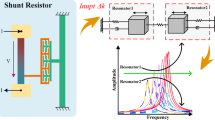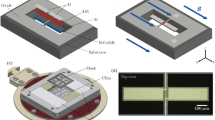Abstract
Resonant magnetoelastic devices are widely used as anti-theft tags and are also being investigated for a range of sensing applications. The vast majority of magnetoelastic devices are operated at resonance, and rely upon an external interface to wirelessly detect the resonant frequency, and other characteristics. For micromachined devices, this detection method must accommodate diminished signal strength and elevated resonant frequencies. Feedthrough of the interrogating stimulus to the detector also presents a significant challenge. This paper describes a method of interrogating wireless magnetoelastic strain sensors using a new frequency-lock approach. Following a brief excitation pulse, the sensor ring-down is analyzed and a feedback loop is used to match the excitation frequency and the resonant frequency. Data acquisition hardware is used in conjunction with custom software to implement the frequency-lock loop. Advantages of the method include temporal isolation of interrogating stimulus from the sensor response and near real-time tracking of resonant frequencies. The method was investigated using a family of wireless strain sensors with resonant frequencies ranging from 120 to 240 kHz. Strain levels extending to 3.5 mstrain and sensitivities up to 14,300 ppm/mstrain were measured with response times faster than 0.5 s. The standard deviation of the locked frequency did not exceed 0.1%.














Similar content being viewed by others
References
Anderson PM III (1982) Magnetomechanical coupling, ΔE effect, and permeability in FeSiB and FeNiMoB alloys. J Appl Phys 53(11):8101
Anderson III PM, Bretts GR, Kearney JE (1985) “Surveillance system having magnetomechanical marker”, US 4510489
Barandiaran JM, Gutierrez J, Gómez-Polo C (2000) New sensors based on the magnetoelastic resonance of metallic glasses. Sens Actuators A Phys 81(1–3):154–157
Berry BS, Pritchet WC (1976) Magnetoelastic phenomena in amorphous alloys. AIP Conf Proc 292(1):292–297
Bozorth RM (1993) Stress and magnetostriction, Ferromagnetism. IEEE Press, New York, p 684
Curran JT, Lachapelle G, Murphy CC (2012) Improving the design of frequency lock loops for GNSS receivers. IEEE Trans Aerosp Electron Syst 48(1):850–868
Dean RN, Rane AK (2013) A digital frequency-locked loop system for capacitance measurement. IEEE Trans Instrum Meas 62(4):777–784
Graff KF (1975) “Longitudinal waves in thin rods”, in Wave Motion in Elastic Solids. Dover Publications, Mineola, pp 75–107
Green SR, Gianchandani YB (2009) Wireless magnetoelastic monitoring of biliary stents. J Microelectromech Syst 18(1):64–78
Grimes CA, Roy SC, Rani S, Cai Q (2011) Theory, instrumentation and applications of magnetoelastic resonance sensors: a review. Sensors 11(3):2809–2844
Huang K, Wentzloff DD (2011) A 60 GHz antenna-referenced frequency-locked loop in 0.13 CMOS for wireless sensor networks. IEEE J Solid-State Circuits 46(12):2956–2965
Huber T, Bergmair B, Vogler C, Bruckner F, Hrkac G, Suess D (2012) Magnetoelastic resonance sensor for remote strain measurements. Appl Phys Lett 101:042402
Jain MK, Cai Q, Grimes CA (2001) A wireless micro-sensor for simultaneous measurement of pH, temperature, and pressure. Smart Mater Struct 10(2):347–353
Johnson ML, Wan J, Huang S, Cheng Z, Petrenko VA, Kim D-J, Chen I-H, Barbaree JM, Hong JW, Chin BA (2008) A wireless biosensor using microfabricated phage-interfaced magnetoelastic particles. Sens Actuators A Phys 144(1):38–47
Joy J, Kroh J, Ellis M, Allen M, Pyle W (2007) “Communicating with implanted wireless sensor”, US 7245117
Khalil W, Shashidharan S, Copani T, Chakraborty S, Kiaei S, Bakkaloglu B (2011) A 700-μ A 405-MHz all-digital fractional-N frequency-locked loop for ISM band applications. IEEE Trans Microw Theory Tech 59(5):1319–1326
Luo Z, Kaye M, Diduch C, Chang L (2011) Frequency measurement using a frequency locked loop. IEEE Energy Convers. Congr. Expo. 1:917–921
O’Dell TH (1982) Measurement of magnetomechanical coupling factor in amorphous ribbons. Phys Status Solidi 74:565
Pepakayala V, Green SR, Gianchandani YB (2014) Passive wireless strain sensors using microfabricated magnetoelastic beam elements. J. Microelectromech Syst 23(6):1374–1382
Sauer S, Marschner U, Adolphi B, Clasbrummel B, Fischer W-J (2012) Passive wireless resonant Galfenol sensor for osteosynthesis plate bending measurement. IEEE Sens J 12(5):1226–1233
Shen W, Zhang Z, Horikawa S, Zhang A, Teng J, Mathison LC, Chin BA (2010) Time domain characterization of magnetoelastic sensors: a pulse method for resonance frequency determination. Rev Sci Instrum 81(8):084702
Tang J, Green SR, Gianchandani YB (2014) Scalable, high-performance magnetoelastic tags using frame-suspended hexagonal resonators. J Micromech Microeng 24(6):065006
Torok E, Hausch G (1978) Magnetoelastic effects of some ferromagnetic metallic glasses. Rapidly Quenched Metals III. The Metals Society, London, pp 105–108
Viswanath A, Green SR, Kosel J, Gianchandani YB (2013) Metglas–Elgiloy bi-layer, stent cell resonators for wireless monitoring of viscosity and mass loading. J Micromech Microeng 23(2):025010
Yoshizawa N, Yamamoto I, Shimada Y (2005) Magnetic field sensing by an electrostrictive/magnetostrictive composite resonator. IEEE Trans Magn 41(11):4359–4361
Zeng K, Ong KG, Mungle C, Grimes CA (2002) Time domain characterization of oscillating sensors: application of frequency counting to resonance frequency determination. Rev Sci Instrum 73(12):4375
Acknowledgements
This work was supported in part by the University of Michigan and in part by the National Institutes of Health through contract 1R01DK102663.
Author information
Authors and Affiliations
Corresponding author
Rights and permissions
About this article
Cite this article
Pepakayala, V., Green, S.R. & Gianchandani, Y.B. Wireless strain measurement with a micromachined magnetoelastic resonator using ringdown frequency locking. ISSS J Micro Smart Syst 6, 3–13 (2017). https://doi.org/10.1007/s41683-017-0001-3
Received:
Accepted:
Published:
Issue Date:
DOI: https://doi.org/10.1007/s41683-017-0001-3




